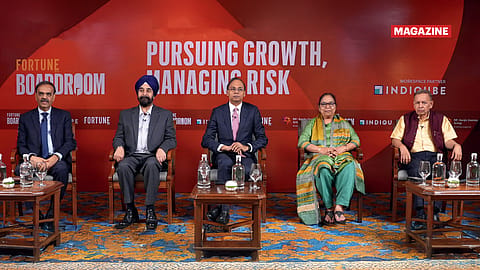Fortune India Boardroom: Leading bankers and experts discuss banking and beyond
At the Fortune India Boardroom, leading bankers and experts highlighted that the time is ripe for the banking sector to take cues from the central bank and match its pace.

This story belongs to the Fortune India Magazine Aug 2025 issue.
A 100-BASIS-POINT repo rate cut, liquidity release of ₹2.5 lakh crore by slashing the cash reserve ratio (CRR) by 1%, eased project finance and gold finance norms, and relaxed liquidity coverage ratio allowing banks to assign lower liquid assets against digital deposits — the Reserve Bank of India (RBI) is not mincing words.
“Since January, we have injected a lot of durable liquidity through various means like CRR cut, open market operations, and buy-sell swaps. A total of ₹9.5 lakh crore of durable liquidity has been injected into the banking system since January. As a result, after remaining in deficit since mid-December, liquidity conditions have transitioned to surplus as of the end of March,” said RBI governor Sanjay Malhotra, as he announced the repo rate cut on June 6. The regulator also deferred the expected credit loss guidelines, which mandated anticipatory loan-loss provisioning by banks.
The slew of liquidity measures, all in under six months, has enthused the banking sector to chase growth. That was the underlying message during Fortune India’s Boardroom on ‘Pursuing Growth, Managing Risks’ held on June 27 in Mumbai. At the event, leading bankers and experts highlighted that the time is ripe for the banking sector to take cues and align with the RBI’s momentum.
According to K.V.S. Manian, MD and CEO of Federal Bank, a mere front-loading of the rate cuts will see the banking sector bouncing back in the third and fourth quarters of the current fiscal. “It is important to have a healthy banking sector to push growth in the economy. Liquidity measures indicate that the RBI is growth-conscious. On the monetary side, we have played our hand. Now, it is for others to pitch in.”
R. Subramaniakumar, MD and CEO, RBL Bank, emphasised the need to accelerate growth. “It (growth) must be all-inclusive. The microfinance risk weight has been relaxed. It indicates policymakers want that segment to be inducted into formal banking,” he said.
Small finance banks, in particular, have welcomed the relaxation of the priority sector lending norms, which will enhance access to credit for sectors crucial to the economy. “The move has opened lending opportunities that will fuel our growth. It is a positive sign that the banking industry and the regulator are working in tandem,” said Inderjit Camotra, MD and CEO, Unity Small Finance Bank. “We are confident that India will become the third-largest economy in four years. The RBI is charged with keeping the banking [system] safe and fit to achieve this growth,” he added.
Maintaining that the central bank is focussed on inflation management as well as growth, Satish Marathe, director, central board, RBI, pointed out that the onus to scout for innovative business models is on banks. “The RBI has been taking proactive steps to ease liquidity. Inflation has been low even during the summer, unlike previous years. The rate cut is very well-timed.”
More Stories from this Issue
Marathe also drew attention to the need for banks to re-examine their business models to chart faster growth. “Despite Jan Dhan accounts, 500 million people still do not have a bank account. Has the financial sector reached out to 750,000 villages in 700 districts?,” asked Marathe, as he underlined that huge resources were still untapped in the rural, semi-urban sector. “Banks are not doing justice to the depositors. While they are paying good dividends to investors, borrowers are getting enticed by low interest rates. Low deposit rate is going to be a big challenge for us,” he added.
Mutual funds vs fixed deposits
As the discussion around new business models progressed, the panel deliberated on the complementary nature of the mutual fund industry, which is often accused of eating into bank deposits. “Traditional savings and investments in India have predominantly been done via multi-asset classes. From savings to mutual funds and crypto in the future, it is part of the growth cycle,” said Gayathri Parthasarathy, partner and leader, financial services, PwC India.
The bankers pointed out that mutual funds and banking services would always have their unique relevance and are part of the same ecosystem. “Customers who are active in equity markets have higher CASA (Current Account Savings Account) balances. We are saying deposits are moving to mutual funds, but where do mutual funds bank?” Manian asked, adding that banks will continue to get deposits and have a long runway.
(INR CR)
“Significant upward migration of customers is taking place in India. Even now, a single-digit percentage of people invest in equities, and a double-digit percentage in mutual funds. Banks must look at the customers as a whole,” he noted.
People cannot take a loan from a mutual fund to buy a house, cited Subramaniakumar. “If someone wants to build a house, they still need a bank loan. The system co-exists and complements each other for the growth of the country.”
Camotra, meanwhile, said banks must encourage mutual funds as it is all about serving the same customer with a variety of offerings. “But the real question is how to bring more liabilities into the regulated economy. Fixed deposits and MFs are two sides of the same coin. The challenge for banks is to grow the pie. Banks must support the customer in his/her journey.”
As the event drew to a close, one thing was evident: the banking sector is confident of staying in rhythm with the government and the RBI.